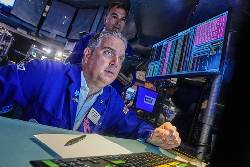NEW YORK (AP) — Stocks wavered on Wall Street Tuesday as trade tensions escalate again with China.
The S&P 500 rose 0.2% in afternoon trading. The index slumped as much as 1.5% earlier in the day as big technology stocks with outsized values offset gains elsewhere. The tech sector remains a heavy weight checking broader gains in the market.
The Dow Jones Industrial Average rose 309 points, or 0.7%, as of 1:05 p.m. Eastern time. The Nasdaq composite slipped 0.2%.
The big swings from morning to afternoon mark yet another sharp twist for markets over the last few days. Wall Street tumbled on Friday for its worst day since April and bounced back on Monday for its best day since May. The swings were prompted by shifting trade sentiment between the U.S. and China.
The latest dip follows China’s Commerce Ministry banning dealings by Chinese companies with five subsidiaries of South Korean shipbuilder Hanwha Ocean, swiping at President Donald Trump’s efforts to rebuild the industry in America. European markets were mixed and Asian markets fell.
Technology stocks are particularly sensitive to trade issues involving China. Big chipmakers and other companies rely on China for raw materials and manufacturing. China's large consumer base is also important for sales growth. Chipmaker Nvidia slumped 2.6%.
The ongoing trade war between the U.S. and the world has been an unpredictable weight on the market. The trade conflict between the U.S. and China is potentially the most economically consequential, owing to those nations’ positions as the two largest economies in the world.
International shipping and shipbuilding have become a major source of friction between Washington and Beijing, with each side imposing new port fees on each others’ vessels. Those fees went into effect on Tuesday.
“We remain cautiously optimistic that both sides will ultimately pursue a negotiated resolution, given the significant economic stakes,” said Ulrike Hoffmann-Burchardi, chief investment officer for the Americas and global head of equities at UBS Global Wealth Management.
The U.S. economy has so far dodged any major impact from the frequently shifting U.S. tariff policies. That could change if nations fall back into a cycle of retaliatory tariffs and companies pass along more of the higher costs to consumers.
The U.S. government shutdown has put a halt to the usual economic updates on inflation, consumer spending and employment. That has made it more difficult for investors and economists to continue gauging the economic impact from tariffs. Wall Street is looking toward the latest round of company earnings and forecasts to get a better sense of the broader economic picture.
Upcoming profit reports will also help Wall Street gauge the broader market's value amid criticism that it has become too expensive after prices rose much faster than corporate profits. For stocks to look less expensive overall, either prices need to fall, or companies’ profits need to rise.
Banks were the first big sector to kick off the latest round of earnings reports and the results hint at Wall Street notching one of its most profitable quarters ever. Still, executives from major banks expressed various degrees of caution about the markets and the economy. JPMorgan Chase slipped 1.3%, Wells Fargo rose 7.6% and Citigroup rose 4.3%.
Health care giant Johnson & Johnson fell 1.1% after announcing that it will separate its orthopedics business into a standalone company.
A lack of updates about the U.S. economy has also left the Federal Reserve without much of the information it uses to make policy decisions. The central bank cut its benchmark interest rate by a quarter of a percentage point in September amid worries that unemployment could worsen. That marked its first cut of the year and Wall Street expects similar cuts at the Fed's meetings in October and December.
Lapses in data about employment and inflation makes it more difficult for the central bank to balance its tasks of both helping to maintain strong employment while keeping prices stable. On Tuesday, Fed Chair Jerome Powell again signaled that the Fed is slightly more worried about the job market.
"Rising downside risks to employment have shifted our assessment of the balance of risks,” he said, at a meeting of the National Association of Business Economics in Philadelphia.
Treasury yields held relatively steady. The yield on the yield on the 10-year Treasury slipped to 4.03% from 4.05% late Friday. Bond markets were closed in the U.S. on Monday for a holiday.
Gold edged 0.6% higher and remains above $4,100 per ounce. The precious metal has soared 57% in 2025 amid a long list of uncertainties, including tariffs and the economy.
___
AP writers Yuri Kageyama, Matt Ott and Christopher Rugaber contributed to this report.
...


